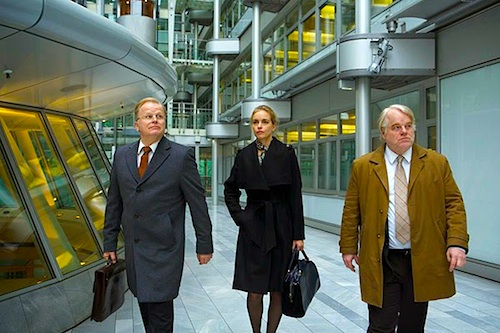By Joe Bendel. Yes, intelligence gathering sometimes involves cloak-and-dagger work, but there is also a lot of bureaucracy. That has always been a side of the secretive business novelist John le Carré has been closely in touch with. For better or worse, all the hallmarks of a le Carré bestseller are to be found in Anton Corbijn’s adaptation of his A Most Wanted Man, which opens this Thursday in New York.
Hamburg was the city where the September 11th terrorist attacks were planned—a fact German intelligence is keenly aware of. It was not Gunther Bachmman’s territory at the time, but the spymaster is still in need of redemption. He was transferred to the port city after his Beirut network was exposed. The who’s, how’s, and why’s remain murky, but there is no question regarding damage done to his career. However, the world weary scotch drinker has big game in his sights: Dr. Faisal Abdullah, an ostensive philanthropist and advocate of Muslim tolerance, whom Bachmann has reason to suspect is furtively funneling funds to terrorist organizations.
Being old school to his bones, Bachmann eschews interrogations or anything physical. He prefers to trap his prey and then turn them into assets. That is the plan with Abdullah, using the poor hapless Issa Karpov as bait. The son of a Chechen woman and a high ranking (and therefore corrupt) Soviet military officer, Karpov understandably identifies with his mother’s side of the family. Escaping his Russian torturers, Karpov has been branded an Islamist terrorist, but Bachmann is skeptical. Dieter Mohr, a more politically sensitive rival from an overlapping agency, would prefer to arrest the Chechen with great fanfare, but Bachmann sees the newly arrived asylum-seeker as an opportunity.
As it turns out, Karpov’s despised old man had an account in Hamburg—an account large enough to be a chip in Bachmann’s game. However, to play it, he will have to handle Karpov’s immigration attorney, Annabel Richter, and Tommy Brue, the banker holding his funds. Unfortunately, Bachmann is a le Carré protagonist, which means he must spend a great deal of time in boardrooms convincing dim-witted ministers to go along with his plan. For now, Martha Sullivan, the regional CIA string-puller, will give him time, but her patience and Bachmann’s trust are limited.
If you like your thrillers talky, you are already a le Carré reader and therefore thoroughly primed for Wanted. On the plus side, Corbijn’s is fully stocked with intelligent characters and meaty dialogue heavy with meaning. Conversely, le Carré’s moral equivalency between all parties is present in full force, as well as an aversion to cinematic action. Although its running time clocks in just over two hours, the ending still feels unsatisfyingly unfinished, leaving viewers to wonder if everyone would really leave things as they are.
Of course, the primary, if not only reason to see Wanted is the late Philip Seymour Hoffman, who fits into the role of Bachmann like a comfortably rumpled suit. Le Carré has said Hoffman is the only American who could play his iconic George Smiley—and it is easy to see what he means. Bachmann and Smiley are clearly cut from same cloth, while Hoffman, Gary Oldman, and Alec Guinness were/are some of the smartest, most engaging actors in the business.

Hoffman’s mushy German accent also works rather well in context, but Rachel McAdams is not nearly as convincing as Richter, the slumming daughter of privilege human rights attorney. At least Willem Dafoe certainly looks at home as Brue, the self-loathing banker. Sadly, Nina Hoss does not have much to do as Bachmann’s lieutenant, Irna Frey, but she classes up the joint, nonetheless. Most of the German cast-members largely serve as window dressing, especially Rush’s Daniel Brühl, who is about as easy to spot as Tony Curtis in The List of Adrian Messenger playing one of Bachmann’s surveillance specialists. Arguably, it is Robin Wright who best hangs with Hoffman, warily sparring with his Bachmann as the suspiciously smooth Sullivan.
Wisely, Andrew Bouvell’s adapted screenplay somewhat waters down the criticism of post-9-11 American foreign policy, but anti-Americanism is baked into the fiber of le Carré’s source novel. Yet, it is the film’s brief but explicit criticisms of Putin’s Russia that feel timelier now. Corbijn has a good eye for the project, capturing the cold, cerebral world of intrigue and modernist architecture. There is much to admire about it, but aside from Hoffman’s haggard everyman performance, the film does its best to keep viewers at arm’s length, like a film that does not want to be wanted. Recommended for knowing fans of le Carré and Hoffman, A Most Wanted Man opens this Thursday night (7/24) in New York at the Landmark Sunshine.
LFM GRADE: B-
Posted on July 22nd, 2014 at 11:47m.
